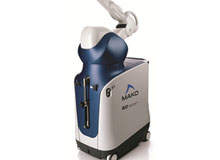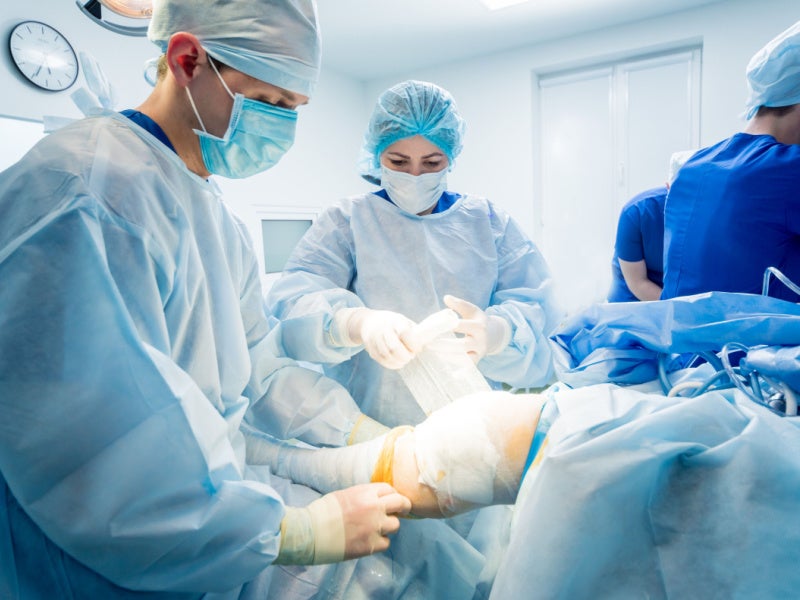
Collaboration is the name of the game in 21st-century health provision. So when Scotland’s largest NHS board, a cutting-edge US healthcare company and the UK’s only doctoral training centre in medical devices joined forces, an outstanding result was guaranteed.
Opened in June 2010, the MAKO Centre for Surgical Robotics, based at the University of Strathclyde’s department of bioengineering, will see the first use of proprietary robotic arm technology outside of the US. The centre will be using advanced techniques that could potentially revolutionise knee surgery across the UK.
Over the three years, MAKO’s RIO robotic arm interactive orthopaedic system will undergo randomised clinical trials at NHS Greater Glasgow and the Clyde Royal Infirmary to assess the benefits of an innovative and precise resurfacing procedure called MAKOplasty. This technique has been widely used in the US since 2006, on patients suffering mid-stage osteoarthritis of the knee. So the multidisciplinary group in Scotland is hoping to bring the same level of millimetre operative accuracy and improved recovery times to the UK. These pioneering techniques will also translate into major cost savings for the NHS. According to the National Rheumatoid Arthritis Society, more than 77,000 knee replacement operations are carried out across the UK annually.
Not all of these would necessarily be suitable candidates for the procedure, but clearly, the advantages to be gained from the anticipated reduced theatre and recuperation times are potentially enormous. And it’s not only knee patients that could reap the benefits. As the University of Strathclyde’s principal, Professor Jim McDonald, said at the centre’s opening ceremony, "the potential for further developments through this new partnership could transform many other aspects of orthopaedic surgery."
Unique surgical precision
See Also:
RIO brings previously unparalleled levels of precision to minimally invasive orthopaedic knee procedures. This comprises a surgeon-interactive tactile platform, incorporating the central robotic arm and unique patient-specific visualisation technology to ensure a personalised result. Bringing a new definition to the concept of key-hole surgery, the system allows accurate and consistently reproducible, tissue-sparing preparatory work to ready the knee joint for the exact insertion and alignment of the company’s RESTORIS implants.
How well do you really know your competitors?
Access the most comprehensive Company Profiles on the market, powered by GlobalData. Save hours of research. Gain competitive edge.

Thank you!
Your download email will arrive shortly
Not ready to buy yet? Download a free sample
We are confident about the unique quality of our Company Profiles. However, we want you to make the most beneficial decision for your business, so we offer a free sample that you can download by submitting the below form
By GlobalDataIndicated for patients suffering with uni or bicompartmental knee disease, the procedure can be exactly tailored to the individual damage present, allowing soft tissue and ligaments to remain intact and maximising the retention of surrounding healthy bone. The net result is the attainment of natural knee kinematics, optimised for the individual concerned – or as MAKO Surgical’s product information puts it, "every patient is unique; every result is precisely beautiful."
Award-winning design
Behind the robotic arm – itself the recipient of a 2010 Gold Award for Medical Design Excellence – which gently guides the surgeon’s hand to achieve this, lies a wealth of innovation and technology. CT-derived 3D modelling accurately plans the size, orientation and alignment of the eventual implant. Furthermore, patient-specific kinematic tracking technology allows pre-resection data to be accurately captured and real-time intra-operative adjustment ensures precision and minimal tissue trauma, promoting faster recovery.
Precisely modelling the articulating surfaces of the knee is, of course, only half the story; a state-of-the-art robotic surgical system calls for an equally cutting-edge implant – and it comes in the form of the RESTORIS MCK multicompartmental knee system. This latest, innovative addition to the RESTORIS family has been specifically developed to complement the new heights of precision that RIO offers, to make new capabilities and enhanced treatment options available.
The uniquely designed components of these implants complement the anatomical resurfacing, with femoral and patella-femoral elements that nest together to allow smooth patella tracking and transition and ensure that a natural range of joint movement can be achieved.
Arthroplasty: a growing market
The demand for knee arthroplasty is widely tipped to rise dramatically in the near to mid term, as the population ages and obesity rates rise. Already, 15 million Americans suffer from osteoarthritis of the knee and with the 55+ sector – the peak group for osteoarthritic knee pain – set to rise three times faster than the rest of the population, and predicted to top 96 million by 2020, that number is bound to rise. So too is the proportion of chronically overweight individuals. Ten years ago, just over 30% of US citizens had a BMI greater than 30; today, estimates put the figure at 40%.
The story in the UK is similar, which makes these clinical trials particularly timely, and in the words of McDonald, "if successful, the centre will contribute to improving the functional outcome of knee surgery patients in Glasgow, reducing pain and helping patients recover more quickly." The experience of patients will, then, be a critical factor.
The patient experience
According to studies by Duke University, a staggering 92% of men and 88% of women surveyed who had been recommended a total hip or knee replacement declined the surgery. The report’s authors cited fear of the pain, anxiety over possibly worsened post-operative mobility, misgivings over the rehabilitation period and a lack of a full understanding of the benefits to be gained as the reasons for this high refusal rate.
Anecdotal evidence also suggests that there is some understandable confusion – and more than a little concern – in the minds of many potential patients about the whole idea of "robot surgeons." For some, it seems, there is just too much sci-fi in the concept, but these are areas where RIO could in reality score particularly well, and with early first-hand results already beginning to filter through, the patient response appears to be particularly positive.
Perhaps most tellingly, among those for whom their current operation is their second, having had conventional techniques used on their first knee, the talk is of markedly less pain and a much shorter stay in hospital – typically three days as opposed to a week or more. If all goes according to plan this may soon drop to under 24 hours.
Human control
For many, there is also the comfort of knowing that for all its Star Trek appearance, RIO remains very definitely under the direct control of a human, unlike its autonomous or even teleoperated brethren. While the robotic arm will gently and effectively resist any attempts to stray off the pre-ordained path, it is the surgeon who actually does the cutting. Advances in medical technology are one thing, but it will always remain important to trust the hand that holds the knife.





